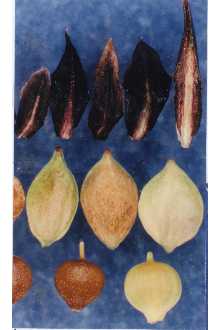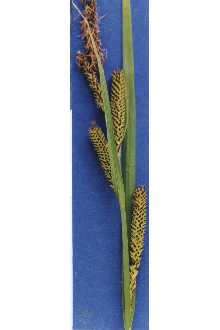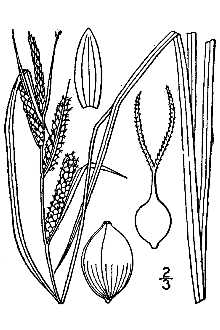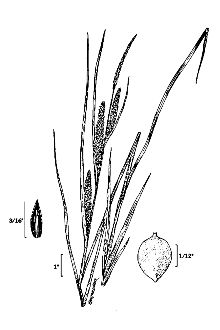Water Sedge
Scientific Name: Carex aquatilis Wahlenb.
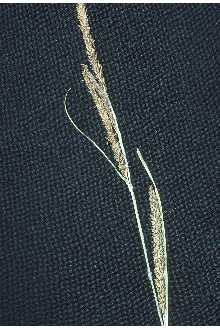
| General Information | |
|---|---|
| Usda Symbol | CAAQ |
| Group | Monocot |
| Life Cycle | Perennial |
| Growth Habits | Graminoid |
| Native Locations | CAAQ |
Plant Guide
Alternate Names
Leafy tussock sedge
Uses
Grazing/rangeland/pasture: Water sedge stays green late into the summer providing good forage when other food sources have gone dormant. Livestock utilization of water sedge is dependent on the time of year and other available forage. It is listed as good palatability for cattle, domestic sheep, and horses with fair nutritional value (Hansen et al., 1990; Kovalchik and Clausnitzer, 2004). Wildlife: Water sedge is grazed by numerous species of geese, swans and other waterfowl. The vegetation also provides a source of cover (Derksen, et al., 1979).The plants are eaten by bison, caribou, mule deer, white-tailed deer, and elk (Cowan, 1945; Hansen et al., 1990; Schaefer and Messier, 1995; Whitten and Cameron, 1980). Water sedge sod forms overhangs along streams providing cover for fish (Hansen, et al., 1994). Erosion control: This species has exceptional value for shoreline erosion control due to its prolific rhizomatous root system. It has also been used to revegetate mined peatlands. Ethnobotanical: Water sedge has been used by several North American native peoples for various purposes. The Gosiute Indians boiled and ate parts of the plant, while Alaska natives ate raw stem bases. The Hesquiat Tribe also used the leaves for basket fiber (Moerman, 1998).
Status
Water sedge is considered a species of special concern in Connecticut, endangered in New Jersey, and threatened in Pennsylvania (USDA-NRCS, 2011). Consult the PLANTS Web site and your State Department of Natural Resources for this plant’s current status (e.g., threatened or endangered species, state noxious status, and wetland indicator values).
Description
General: Sedge Family (Cyperaceae). Water sedge is a sod-forming perennial grass-like sedge growing 15 to 100 cm (6 to 40 in) tall. Plants arise singly or in groups connected by thick, long rhizomes. The stems or culms are triangular in cross section. Leaves are borne on the lower half of the stems; the blades are 1.5 to 5.5 mm (0.06 to 0.22 in) wide and can be shorter or longer than the culms. Each culm has a leaf-like, 3 to 19 cm (1.2 to 7.5 in) long bract subtending the inflorescence. The inflorescence consists of 1 to 3 staminate spikes above 2 to 3 pistillate spikes, often with some androgynous (male and female with male flowers on top) transitional spikes. The terminal staminate spike is 1 to 3.5 cm (0.4 to 1.4 in) long. The pistillate spikes are 1.5 to 4.5 cm (0.6 to 1.8 in) long and 3 to 5 mm (0.12 to 0.20 in) wide. Each fruit (achene) is subtended by a lanceolate to rounded, blackish or black purple scale, shorter to longer and narrower than the perigynia. The scale has a green to pale brown midrib. Each achene is enclosed in a perigynium, a leathery sack- like structure. The perigynia are 2 to 3.3 mm (0.08 to 0.13 in) long. The achenes are lenticular (lens shaped) with 2 stigmas (Welsh et al., 2003). Water sedge inflorescence with pistillate (female) spikes below and staminate (male) spikes above. Phot by Derek Tilley
Distribution
Water sedge is a circumboreal species. In North America it occurs from the Arctic to as far south as California, Arizona, New Mexico and Virginia (USDA-NRCS, 2011). For current distribution, consult the Plant Profile page for this species on the PLANTS Web site. Habitat: Water sedge occurs in wet and boggy meadows, stream banks, and pond and lake margins. It is often found with other wetland herbaceous species including other sedges (Carex spp.), rushes (Juncus spp.), and bulrushes (Schoenoplectus spp.). It can be found in large monoculture stands and also in open areas of riparian sites associated with willows (Salix spp.), cottonwood (Populus spp.), and birch (Betula spp.) plant communities.
Adaptation
Water sedge can be found from sea level to over 3,350 m (11,000 ft) in elevation. It is adapted to temperatures reaching as low as -20° C (-4° F). Water sedge grows in sites where the water table is near the soil surface in the toe and bank zones, and can withstand 1 to 2 months of submersion. This species is shade intolerant; it likes open disturbed areas. Depending on the site, water sedge can act as a pioneer or climax species.
Management
The soil should be kept saturated with no more than 2.5 to 5.1 cm (1 to 2 in) of standing water until the plants are well established and the aerenchymous material (the above ground biomass) is about 0.3 m (12 in) tall. Fluctuating water levels during the establishment period may speed establishment and spread. Water levels can be managed to enhance rhizome spread and to control weeds.
Pests and Potential Problems
There are no known pests or other problems associated with water sedge.
Environmental Concerns
Concerns , Use soil moisture sensors to measure the soil moisture of Water Sedge.
Concerns
There are no known environmental concerns relating to water sedge.
Seed and Plant Production
Plant Production
Plant Production
Water sedge is wind pollinated and primarily cross pollinated. Flowers bloom from late May to September depending on latitude (Hauser, 2006). Reproduction is largely asexual via spreading rhizomes. Seedling recruitment occurs, but is infrequent. Collection and Cleaning: Seed is most commonly collected by hand. Fruiting heads can be cut from stems using shears or a hand scythe. Seed is hard and brown when ripe. Seed is air dried in paper sacks for several weeks prior to processing. Seed is removed from stem using a hammer mill with a 0.6 cm (0.25 in) screen. Seed is then pre cleaned using a small-lot air screen cleaner with a 1.80 mm (0.07 in) screen to remove stems and other inert matter. The perigynium is then removed from the seed using a corrugated rubbing board or hammer mill and then re-cleaned with a 1.55 mm (0.06 in) screen and light air. Purities of over 95% are typical (Tilley, 2010). There are approximately 450,000 seeds/lb with perigynium still intact, and 900,000 seeds/lb with perigynium removed. Greenhouse Plant Production: A 30 day cold/moist stratification may be used, but research at the Aberdeen Plant Materials Center shows that this is not necessary with hot temperatures and high moisture levels. For 10 in³ conetainers, place 5 to 25 seeds on the soil surface and press the seed in for good seed-to-soil contact. Seed should not be covered with any soil or sand, but kept moist with an overhead mist irrigation schedule of 2 minutes/hr from 9:00 am to 5:00 pm for the first 30 days. Day time greenhouse temperatures range from 32 to 43° C (90 to 110° F). Night time temperatures average around 30° C (85° F). Grow lights are kept on during nighttime hours. First emergence occurs around 5 to 7 days after planting. Full stands (90-100%) are reached in 12 days. After full establishment, plants can be fertilized once per week with Miracle Grow All Purpose Plant
Food
(15-30-15). After 30 days the irrigation amount should be increased to 3 minutes/hr from 9:00 am to 5:00 pm and grow lights are turned off. Greenhouse day time temperatures are reduced to 30 to 32°C (85 to 90° F). Plants are ready for transplanting in 3 months.
Establishment
Wild plants can be collected and transplanted directly into the desired project site. Care should be taken not to collect plants from weedy areas as these weeds can be relocated to the transplant site and the hole left at the collection site may fill with undesirable species. For wetland plantings using greenhouse grown transplants or wildings, plant at 15, 30 or 60 cm (0.5, 1.0 or 2.0 ft) spacing for uniform ground cover in 1, 2 and 3 years respectively. Seedlings can be hand-planted or dibbled into moist soil or standing water. Cultivars, Improved, and Selected Materials Wild collected seed is commercially available, but there are no known releases of water sedge.
References
Cowan, Ian McTaggart. 1945. The ecological relationships of the food of the Columbian black-tailed deer, Odocoileus hemionus columbianus (Richardson), in the coast forest region of southern Vancouver Island, British Columbia. Ecological Monographs. 15(2): 110-139. Derksen, Kirk V.; Weller, Milton W.; Eldridge, William D. 1979. Distributional ecology of geese molting near Teshekpuk Lake, National Petroleum Reserve--Alaska. In: Jarvis, Robert. L.; Bartonek, James. C., eds. Management and biology of Pacific Flyway geese: a symposium; 16 February 1979; Portland, OR. Corvallis, OR: Hansen, Paul; Boggs, Keith; Pfister, Robert; Joy, John. 1990. Classification and management of riparian and wetland sites in central and eastern Montana. Missoula, MT: University of Montana, School of Forestry, Montana Forest and Conservation Experiment Station, Montana Riparian Association. 279 p. Hansen, Paul L.; Boggs, Keith; Pfister, Robert D.; [and others]. 1994. Classification and management of riparian and wetland sites in Montana. In: Hamre, R. H., ed. Workshop on western wetlands and riparian areas: public/private efforts in recovery, management, and education: Proceedings; 1993 September 9-11; Snowbird, UT. Boulder, CO: Thorne Ecological Institute: 1-17. Hauser, A. Scott. 2006. Carex aquatilis. In: Fire Effects Information System, [Online]. U.S. Department of Agriculture, Forest Service, Rocky Mountain Research Station, Fire Sciences Laboratory (Producer). Available: http://www.fs.fed.us/database/feis/ Kovalchik, Bernard L.; Clausnitzer, Rodrick R. 2004. Classification and management of aquatic, riparian, and wetland sites on the national forests of eastern Washington: series description. Gen. Tech. Rep. PNW-GTR-593. Portland, OR: U.S. Department of Agriculture, Forest Service, Pacific Northwest Research Station. 354 p. Moerman, D.E. 1998. Native American Ethnobotany. Timber Press. 927 p. Schaefer, James A.; Messier, Francois. 1995.
Plant Traits
Growth Requirements
| Temperature, Minimum (°F) | -38 |
|---|---|
| Adapted to Coarse Textured Soils | No |
| Adapted to Fine Textured Soils | Yes |
| Adapted to Medium Textured Soils | Yes |
| Anaerobic Tolerance | High |
| CaCO3 Tolerance | High |
| Cold Stratification Required | No |
| Drought Tolerance | Low |
| Fertility Requirement | Medium |
| Fire Tolerance | Low |
| Frost Free Days, Minimum | 120 |
| Hedge Tolerance | None |
| Moisture Use | High |
| pH, Maximum | 7.5 |
| pH, Minimum | 4.0 |
| Planting Density per Acre, Maxim | 4800 |
| Planting Density per Acre, Minim | 3450 |
| Precipitation, Maximum | 65 |
| Precipitation, Minimum | 15 |
| Root Depth, Minimum (inches) | 14 |
| Salinity Tolerance | None |
| Shade Tolerance | Intolerant |
Morphology/Physiology
| After Harvest Regrowth Rate | Slow |
|---|---|
| Toxicity | None |
| Resprout Ability | No |
| Shape and Orientation | Erect |
| Active Growth Period | Summer |
| Bloat | None |
| Coppice Potential | No |
| Fall Conspicuous | No |
| Fire Resistant | Yes |
| Flower Color | Green |
| Flower Conspicuous | No |
| Foliage Color | Green |
| Foliage Porosity Summer | Porous |
| Foliage Porosity Winter | Porous |
| Fruit/Seed Color | Yellow |
| Nitrogen Fixation | None |
| Low Growing Grass | No |
| Lifespan | Long |
| Leaf Retention | No |
| Known Allelopath | No |
| Height, Mature (feet) | 2.9 |
| Growth Rate | Moderate |
| Growth Form | Bunch |
| Fruit/Seed Conspicuous | No |
| Foliage Texture | Fine |
Reproduction
| Vegetative Spread Rate | None |
|---|---|
| Small Grain | No |
| Seedling Vigor | Medium |
| Seed Spread Rate | Slow |
| Fruit/Seed Period End | Fall |
| Propagated by Tubers | No |
| Propagated by Sprigs | Yes |
| Propagated by Sod | No |
| Propagated by Seed | Yes |
| Propagated by Cuttings | No |
| Propagated by Container | No |
| Propagated by Bulb | No |
| Propagated by Bare Root | No |
| Fruit/Seed Persistence | No |
| Fruit/Seed Period Begin | Summer |
| Fruit/Seed Abundance | Medium |
| Commercial Availability | Routinely Available |
| Bloom Period | Summer |
| Propagated by Corm | No |
Suitability/Use
| Veneer Product | No |
|---|---|
| Pulpwood Product | No |
| Protein Potential | Medium |
| Post Product | No |
| Palatable Human | No |
| Palatable Graze Animal | Medium |
| Nursery Stock Product | No |
| Naval Store Product | No |
| Lumber Product | No |
| Fodder Product | No |
| Christmas Tree Product | No |
| Berry/Nut/Seed Product | No |

